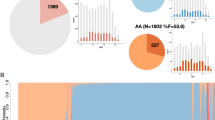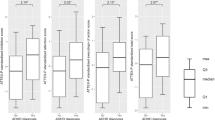Abstract
The Pediatric Symptom Checklist (PSC) is a widely used, parent-completed measure of children’s emotional and behavioral functioning. Previous research has shown that the PSC and its subscales are responsive to patient progress over the course of psychiatric treatment. In this naturalistic study, parents and clinicians of 1736 patients aged 17 or younger completed standardized measures at intake and 3-month follow-up appointments. We assessed the 5-item PSC Attention Subscale (PSC–AS) as a longitudinal measure of attention-related symptoms in routine outpatient psychiatry treatment. Secondarily, we compared PSC–AS scores with clinician-reported diagnoses, psychomotor excitation symptoms, and overall functioning. Change scores on the PSC–AS were larger among patients with ADHD diagnoses than those with non-ADHD diagnoses. Comparisons between PSC–AS scores and clinician reports also showed acceptable levels of agreement. Given its effectiveness in tracking attention-related symptoms, the PSC may be particularly useful as a quality assurance or treatment outcome measure for clinicians treating ADHD.

Similar content being viewed by others
Explore related subjects
Discover the latest articles and news from researchers in related subjects, suggested using machine learning.References
Froehlich TE, Lanphear BP, Epstein JN, Barbaresi WJ, Katusic SK, Kahn RS (2007) Prevalence, recognition, and treatment of attention-deficit/hyperactivity disorder in a national sample of US children. Arch Pediatr Adolesc Med 161:857–864
Scottish Intercollegiate Guidelines Network (2009) Management of attention deficit and hyperkinetic disorders in children and young people: a national clinical guideline. Scott Intercoll Guidel Netw, Edinburgh
Pelham WE, Foster EM, Robb JA (2007) The economic impact of attention-deficit/hyperactivity disorder in children and adolescents. Ambul Pediatr 7:121–131
Swensen A, Birnbaum HG, Hamadi RB, Greenberg P, Cremieux PY, Secnik K (2004) Incidence and costs of accidents among attention-deficit/hyperactivity disorder patients. J Adolesc Health 35:346.e1–346.e9
Barkley RA (1998) Attention deficit hyperactivity disorder: a handbook for diagnosis and treatment, 2nd edn. Guilford, New York
Feldman HM, Reiff MI (2014) Attention deficit–hyperactivity disorder in children and adolescents. N Engl J Med 370:838–846
Jensen PS, Arnold LE, Swanson JM, Vitiello B, Abikoff HB, Greenhill LL et al (2007) 3-Year follow-up of the NIMH MTA study. J Am Acad Child Adolesc Psychiatry 46:989–1002
MTA Cooperative Group (2004) National Institute of Mental Health multimodal treatment study of ADHD follow-up: 24-month outcomes of treatment strategies for attention-deficit/hyperactivity disorder. Pediatrics 113:754–761
Conners CK, Sitarenios G, Parker JD, Epstein JN (1998) The revised Conners’ Parent Rating Scale (CPRS-R): factor structure, reliability, and criterion validity. J Abnorm Child Psychol 26:257–268
Wolraich ML, Lambert W, Doffing MA, Bickman L, Simmons T, Worley K (2003) Psychometric properties of the Vanderbilt ADHD diagnostic parent rating scale in a referred population. J Pediatr Psychol 28:559–568
Jellinek M, Murphy JM, Robinson J, Feins A, Lamb S, Fenton T (1988) Pediatric Symptom Checklist: screening school-age children for psychosocial dysfunction. J Pediatr 112:201–209
Gardner W, Murphy JM, Childs G, Kelleher K, Pagano M, Jellinek M (1999) The PSC-17: a brief pediatric symptom checklist with psychosocial problem subscales. A report from PROS and ASPN. Ambulatory Child Health 5:225–236
Murphy JM, Masek BJ, Babcock R, Jellinek M, Gold J, Drubner S et al (2011) Measuring outcomes in outpatient child psychiatry: the contribution of electronic technologies and parent report. Clin Child Psychol Psychiatry 16:146–160
Murphy JM, Kamin HS, Masek B, Vogeli C, Caggiano R, Sklar K et al (2012) Using brief clinician and parent measures to track outcomes in outpatient child psychiatry: longer term follow-up and comparative effectiveness. Child Adolesc Ment Health 17:222–230
Murphy JM, Blais MA, Baer L, McCarthy A, Kamin H, Masek B (2013) Measuring outcomes in outpatient child psychiatry: reliable improvement, deterioration, and clinically significant improvement. Clin Child Psychol Psychiatry. doi:10.1177/1359104513494872
Murphy JM, Guzmán J, McCarthy AE, Squicciarini AM, George M, Canenguez K et al (2014) Mental health predicts better academic outcomes: a longitudinal study of elementary school students in Chile. Child Psychiatry Hum Dev. doi:10.1007/s10578-014-0464-4
Hacker KA, Williams S, Mysgmarjav S, Cabral H, Murphy M (2009) Persistence and change in pediatric symptom checklist scores over 10–18 months. Acad Pediatr 9:270–277
Kamin HS, McCarthy AE, Abel MR, Jellinek MS, Baer L, Murphy JM (2014) Using a brief parent-report measure to track outcomes for children and teens with internalizing disorders. Child Psychiatry Hum Dev. doi:10.1007/s10578-014-0525-8
Jacobson NS, Truax P (1991) Clinical significance: a statistical approach to defining meaningful change in psychotherapy research. J Consult Clin Psychol 59:12–19
Evans C, Margison F, Barkham M (1998) The contribution of reliable and clinically significant change methods to evidence-based mental health. Evid Based Ment Health 1:70–72
Anastopoulos AD, Shelton TL, DuPaul GJ, Guevremont DC (1993) Parent training for attention-deficit hyperactivity disorder: its impact on parent functioning. J Abnorm Child Psychol 21:581–596
Beck SJ, Hanson CA, Puffenberger SS, Benninger KL, Benninger WB (2010) A controlled trial of working memory training for children and adolescents with ADHD. J Clin Child Adolesc Psychol 39:825–836
Jones K, Daley D, Hutchings J, Bywater T, Eames C (2007) Efficacy of the incredible years basic parent training programme as an early intervention for children with conduct problems and ADHD. Child Care Health Dev 33:749–756
Gardner W, Lucas A, Kolko DJ, Campo JV (2007) Comparison of the PSC-17 and alternative mental health screens in an at-risk primary care sample. J Am Acad Child Adolesc Psychiatry 46:611–618
Hughes CW, Rintelmann J, Emslie GJ, Lopez M, MacCabe N (2001) A revised anchored version of the BPRS-C for childhood psychiatric disorders. J Child Adolesc Psychopharmacol 11:77–93
Shaffer D, Gould MS, Brasic J, Ambrosini P, Fisher P, Bird H et al (1983) A children’s global assessment scale. Arch Gen Psychiatry 40:1228–1231
American Psychiatric Association (2000) Diagnostic and statistical manual of mental disorders, DSM-IV-TR. American Psychiatric Association, Washington, DC
Kleinman RE, Hall S, Green H, Patton K, Pagano ME, Murphy JM (2002) Diet, breakfast, and academic performance in children. Ann Nutr Metab 46(Suppl 1):24–30
Stein BD, Jaycox LH, Kataoka SH, Wong M, Tu W, Elliott MN (2003) A mental health intervention for schoolchildren exposed to violence: a randomized controlled trial. JAMA 290:603–611
Plante TG, Couchman CE, Diaz AR (1995) Measuring treatment outcome and client satisfaction among children and families. J Ment Health Adm 22:261–269
Henderson L, McIlhaney K, Wasser T (2010) Measuring outcomes of multiple diagnosis groups in residential treatment using the Brief Psychiatric Rating Scale for Children (BPRS-C). Child Youth Serv Rev 32:98–102
Overall JE, Pfefferbaum B (1982) The brief psychiatric rating scale for children. Psychopharmacol Bull 18:10–16
Shafer AB (2013) Factor structure of the Brief Psychiatric Rating Scale for Children (BPRS-C) among hospital patients and community clients. Pers Individ Dif 55:41–46
Gold J, Buonopane R, Caggiano RA, Picciotto M, Vogeli C, Kanner NT et al (2009) Assessing outcomes in child psychiatry. Am J Manag Care 15:210–216
Lundh A, Kowalski J, Sundberg CJ, Gumpert C, Landén M (2010) Children’s Global Assessment Scale (CGAS) in a naturalistic clinical setting: inter-rater reliability and comparison with expert ratings. Psychiatry Res 177:206–210
Cohen J (1998) Statistical power analysis for the behavioral science, 2nd edn. Erlbaum, Hillsdale
Gershon J, Gershon J (2002) A meta-analytic review of gender differences in ADHD. J Atten Disord 5:143–154
Brown CH, Liao J (1999) Principles for designing randomized preventive trials in mental health: an emerging developmental epidemiology paradigm. Am J Community Psychol 27:673–710
Minami T, Wampold BE, Serlin RC, Hamilton EG, Brown GS, Kircher JC (2008) Benchmarking the effectiveness of psychotherapy treatment for adult depression in a managed care environment: a preliminary study. J Consult Clin Psychol 76:116–124
Castonguay LG, Boswell JF, Zack SE, Baker S, Boutselis MA, Chiswick NP et al (2010) Helpful and hindering events in psychotherapy: a practice research network study. Psychotherapy (Chic) 47:327–344
Blais MA, Sinclair SJ, Baity MR, Worth J, Weiss AP, Ball LA (2012) Measuring outcomes in adult outpatient psychiatry. Clin Psychol Psychother 19:203–213
Spencer AE, Chiang C, Plasencia N, Biederman J, Murphy JM, Jellinek MS (2015) Screening and tracking cases of ADHD in an outpatient pediatric practice: measures and clinical diagnoses over time. Massachusetts General Hospital, Boston. Unpublished manuscript
TeenScreen National Center for Mental Health Checkups at Columbia University. Incorporating mental health screen into adolescent office visits- PSC-Y. http://www.nachc.com/client/documents/exteenscreen/PSC-Y%20Pad.pdf. Accessed 7 May 2015
Massachusetts Government Department of Health and Human Services. The Mass-Health Approved Screening Tools: PSC-Y. http://www.mass.gov/eohhs/gov/commissions-and-initiatives/cbhi/screening-for-behavioral-health-conditions/the-masshealth-approved-screening-tools/y-psc.html. Accessed 7 May 2015
Acknowledgments
A portion of the planning and data analysis for this study was made possible by a Grant from the Fuss Family Fund. The support of the Fuss Family Fund is hereby gratefully acknowledged.
Author information
Authors and Affiliations
Corresponding author
Ethics declarations
Conflict of interest
Dr. Timothy Wilens receives or has received grant support from the following sources: NIH(NIDA). He is or has been a consultant for: Euthymics/Neurovance, NIH(NIDA), Ironshore, Sunovion and TRIS. He has a published book: Straight Talk About Psychiatric Medications for Kids (Guilford Press); and co/edited books ADHD in Children and Adults (Cambridge Press), and Massachusetts General Hospital Comprehensive Clinical Psychiatry (Sage). He is co/owner of a copyrighted diagnostic questionnaire (Before School Functioning Questionnaire). He has a licensing agreement with Ironshore (BSFQ Questionnaire). Dr. Wilens is Chief, Division of Child and Adolescent Psychiatry, and (Co) Director of the Center for Addiction Medicine at Massachusetts General Hospital. He serves as a consultant to the US National Football League (ERM Associates), US Minor/Major League Baseball, and Bay Cove Human Services (Clinical Services).
Rights and permissions
About this article
Cite this article
McCarthy, A., Asghar, S., Wilens, T. et al. Using a Brief Parent-Report Measure to Track Outcomes for Children and Teens with ADHD. Child Psychiatry Hum Dev 47, 407–416 (2016). https://doi.org/10.1007/s10578-015-0575-6
Published:
Issue Date:
DOI: https://doi.org/10.1007/s10578-015-0575-6




